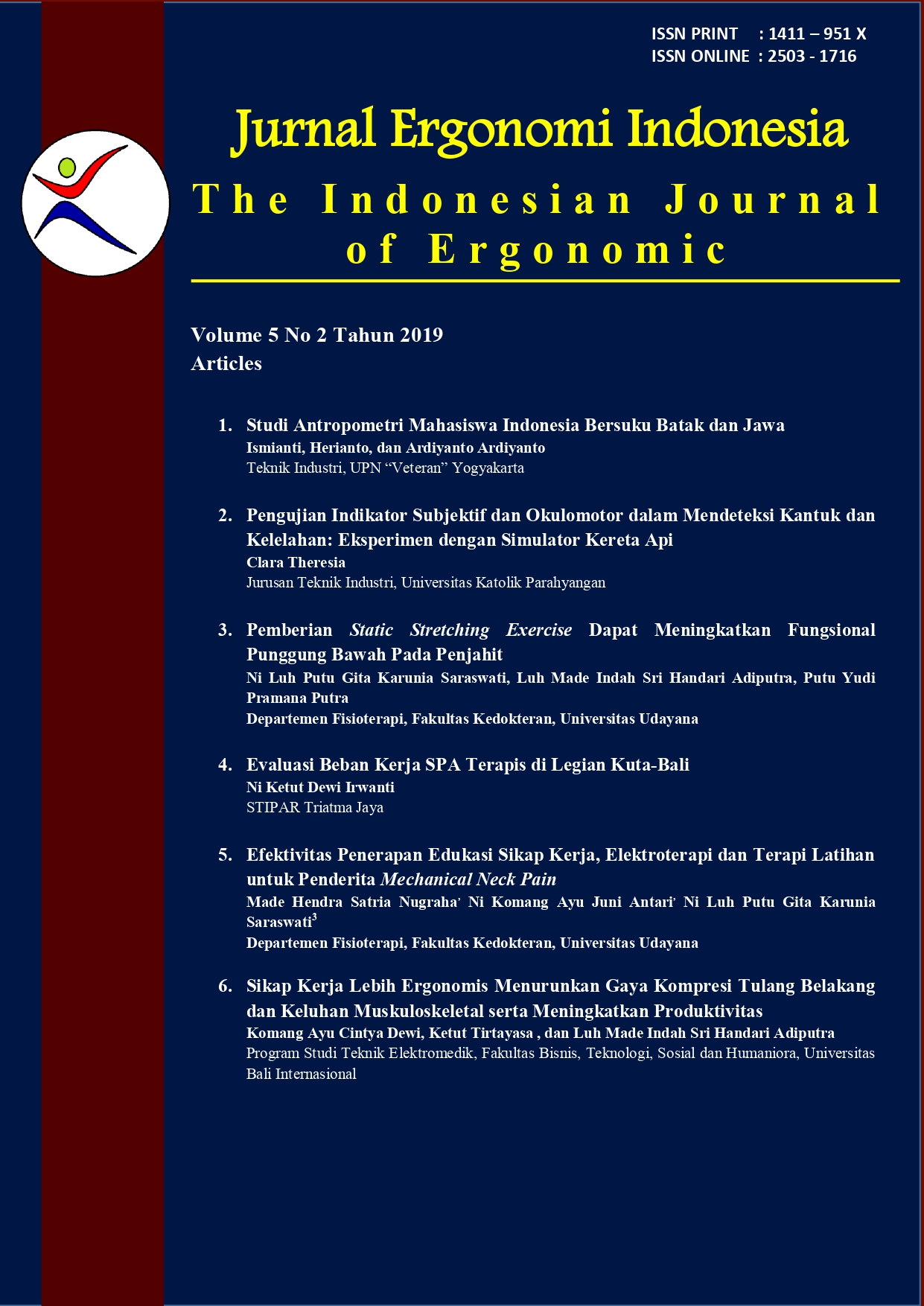Pengujian Indikator Subjektif dan Okulomotor dalam Mendeteksi Kantuk dan Kelelahan: Eksperimen dengan Simulator Kereta Api
Abstract
Kelelahan dan kantuk merupakan faktor yang berkontribusi terhadap kecelakaan khususnya disektor transportasi. Sejumlah pengukuran subjektif dan objektif dapat digunakan sebagai indikator pendeteksi kelelahan dan kantuk. Penelitian ini bertujuan untuk melakukan investigasi apakah terdapat korelasi antara Karolinska sleepiness Scale sebagai indikator kantuk subjektif terhadap frekuensi kedipan sebagai indikator okulomotor objektif dalam mendeteksi kelelahan dan kantuk. Penelitian ini melibatkan 12 orang partisipan yang mengemudikan simulator kereta api selama 4 jam perjalanan. Setiap partisipan mengalami tiga perlakuan kuantitas tidur pada malam sebelum eksperimen yaitu kondisi tidur ekstrim (2 jam), moderate (4 jam) dan normal (8 jam). Penilaian kelelahan dan kantuk menggunakan 2 indikator yaitu indikator kantuk subjektif dengan Karolinska Sleepiness Scale dan indikator pergerakan mata berupa frekuensi kedipan per menit dari rekaman video kamera sepanjang perjalanan. Temuan utama pada penelitian ini yaitu adanya korelasi positif kuat antara indikator kantuk subjektif terhadap indikator okulomotor berupa frekuensi kedipan per menit khususnya untuk kondisi tidur moderate 4 jam (r=0.861, p=0.013). Korelasi yang kuat antara keduanya menunjukkan bahwa kedua indikator baik subjektif maupun okulomotor dapat saling mendukung dalam mendeteksi kantuk dan kelelahan. Temuan lainnya bahwa skor KSS>5 terjadi setelah satu jam mengemudi untuk kondisi sleep deprivation ekstrim 2 jam dan terjadi setelah 160 menit mengemudi pada kondisi tidur moderate 4 jam.
Downloads
References
Baysari, M. T, Mc Intosh A. S., Wilson, J. R. 2008. Understanding the human factors contribution to railways accidents and incidents in Australia. Accident Analysis Prevention, Vol. 40:1750-1757.
Caffier, P.P., Erdmann, U., Ullsperger, P. 2003. Experimental evaluation of eye-blink parameters as a drowsiness measure. European Journal Applied Physiology, Vol. 89(3-4):319-325.
Craig, A., Tran, Y., Wijesuriya, N. 2011. Psychophysiological Characteristics of Driver Fatigue. In Joris C Verster and Charles F P George (Eds.), Sleep, Sleepiness and Traffic Safety. New York: Nova Science Publishers. pp. 65-91.
Dawson, D., Searle, A. K., Paterson, J. L. 2014. Look before you (s)leep: Evaluating the use of fatigue detection technologies within a fatigue risk management system for the road transport industry. Sleep Medicine Review, Vol.18:141-152.
Dorrian, J., Hussey, F., Dawson, D. 2007. Train driving efficiency and safety: examining the cost of fatigue. Journal of Sleep Research, Vol. 16:1-11. https://www.ncbi.nlm.nih.gov/pubmed/17309757
Dunn, N dan Williamson, A. 2012. Driving monotonous routes in train simulator: the effect of task demand on driving performance and subjective experience. Ergonomics, Vol. 55:997-1008. https://www.tandfonline.com/doi/abs/10.1080/00140139.2012.691994?journalCode=terg20
Iridiastadi, H dan Ikatrinasari, ZF. 2012. Indonesian railway accidents utilizing Human Factors Analysis and Classification system in determining potential contributing factors. Work, Vol. 41(1):4246-4249.
Kaida, K., Takahashi, M., Akerstedt, T., Nakata, A., Otsuka, Y., Haratani, T., Fukusawa, K. 2006. Validation of the karolinska sleepiness scale against performance and EEG variables. Clinical Neurophysiology, Vol. 117(7):1574-1581. https://doi.org/10.1016/j.clinph.2006.03.011
Kim, D.S. dan Yoon, W.C. 2013. Accident causation model for railway industry: application of the model to 80 rail accident investigation reports from the UK. Safety Science. Vol. 60:57-68.
Komite Nasional Keselamatan Transportasi. 2016. Data Investigasi Kecelakaan Perkeretaapian Tahun 2010-2016. Database KNKT, 31 Oktober 2016.
Kosmadopoulos, A., Sargent, C., Zhou, X., Darewent, D., Matthews, R,W., Dawson, D., Roach, G, D. 2017. The efficacy of objective and subjective predictors of driving performance during sleep restriction and circadian misalignment. Accident Analysis and Prevention, Vol. 1(99):445-451.
Kryger, M., Roth, T., Dement, W.C. 2016. Principles and practice of sleep medicine. Sixth Edition. Philadelphia: Elsevier, Chapter 2 pp.19-21.
Lal, S. K. L. dan Craig, A. A. 2001. Critical review of the psychophysiology of driver fatigue, Biological Psychology, Vol. 55:173-194. https://doi.org/10.1016/S0301-0511(00)00085-5
Mahachandra, M., Yassierli, Sutalaksana, I. Z., Suryadi, K. 2011. Sleepiness patern of Indonesian professional driver based on subjective scale and eye closure activity, International Journal of Basic and Applied Sciences, Vol. 11(6):87-96.
Pauly, L., dan Shankar, D. 2015. Detection of Drowsiness based on HOG features and SVM classifiers. Proceedings of IEEE International Conference on Computer Graphics, Vision and Information Security (CGVIS)
Philip, P dan Akerstedt, T. 2006. Transport and industrial safety How they affected by sleepiness and sleep restriction. Sleep Medicine Review, Vol. 10(5):347-356. https://doi.org/10.1016/j.smrv.2006.04.002
Schleicher, R., Galley, N., Briest, S., Galley, N. 2008. Blink and saccades as indicator of fatigue in sleepiness warning: looking tired? Ergonomic, Vol. 51(7):982-1010. https://doi.org/10.1080/00140130701817062
Theresia, C., Iridiastadi, H., Pratama, G.B. 2018. Impact of sleep deprivation on vigilance, fatigue and performance during simulated train driving. Proceedings of the 2nd International Conference on High Performance and Compilation, Computing and Communications. Hong Kong: ACM Publishers, pp 45-50.

















